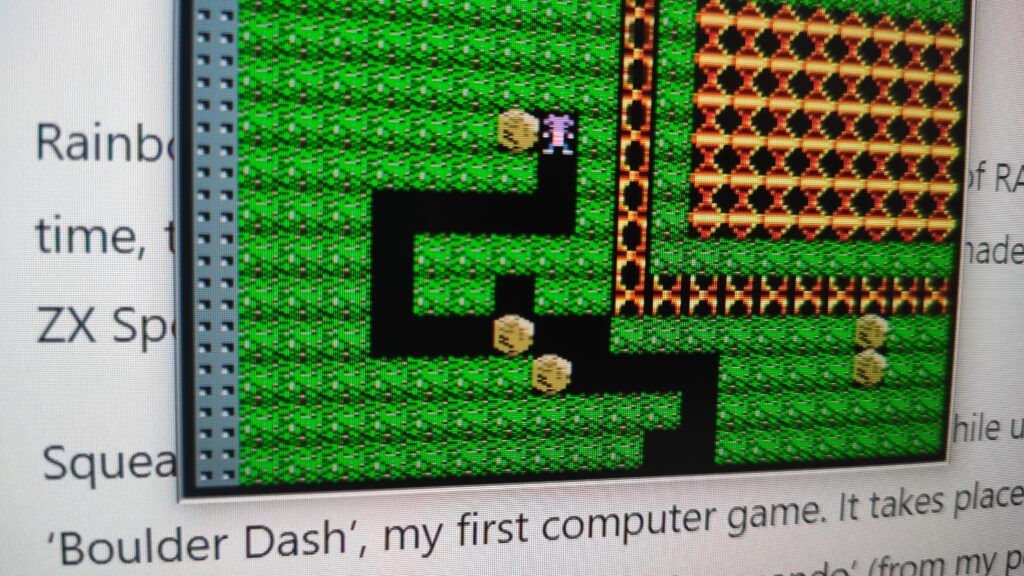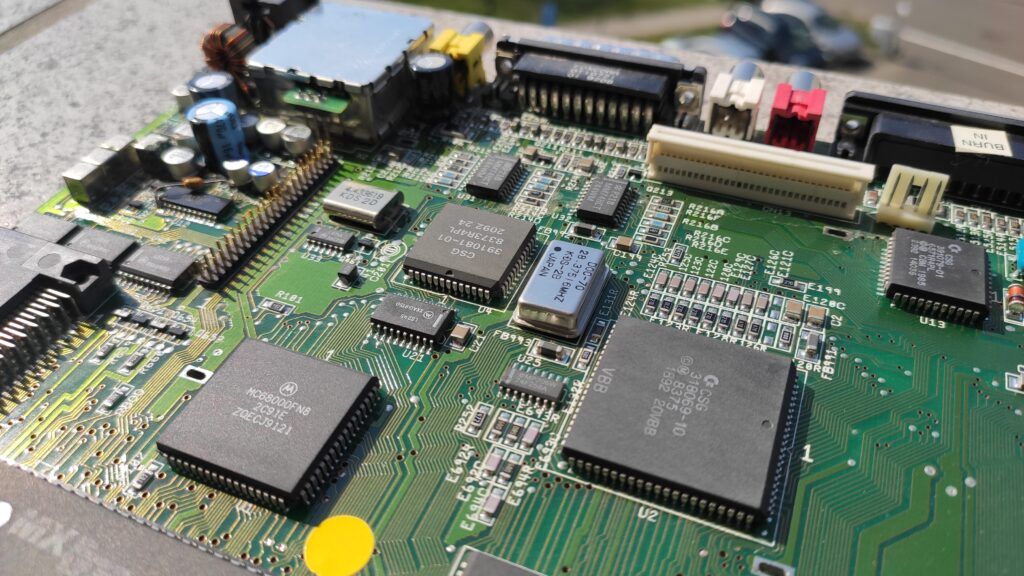Anna Ochmann
A huge, rectangular industrial hall — Silesia of my childhood is peppered with them. But this one differs from a typical factory hall. The cleanliness and intense glow of fluorescent lamps make you feel like you are not in a hall, but rather in an operation theatre. Plus the ‘equipment’. The large, open space is filled with a maze of strange metal-glass ‘cabinets’ containing large spool-disks. I gaze with delight as one of them spits a steady long print filled with X-s and 0-s arranged in Mickey Mouse’s drawing… In a moment, with specific crackling-and-rattling noise, the duck’s feet are slowly printing… ‘Donald Duck’, I shout, happy that I recognised another X-0 character…
I zealously fill all the shapes of Disney characters with crayons sitting on the ground in front of the row of ‘wardrobes’. A tangled web of printers connected to two computers (also the size of cabinets) lurks above me. It’s ‘George’. I still remember the noise of air conditioning — regular, but after a while less and less perceptible. A constant temperature in the room is very important. George should not be overheated.
I sharpen the pencils while my grandfather patiently explains what it is all about. The strange contraptions count salaries for miners and print their ‘payslips’. There are only two such machines in Poland. The second one works for the Central Statistical Office in Katowice. Mining is a very powerful industry in Poland in the 1980s, so it can afford to buy such equipment. And, thanks to my Grandfather, I get to know THIS word…
Computer.
***
My parents belong to a generation of Radio Free Europe which is illegal in the then Poland. Its characteristic signal has accompanied me from the earliest childhood. Broadcasts and songs by Jacek Kaczmarski shape me in my salad days — as much as ‘unofficial’ reading. To this day, I remember the first sentences of Hemingway’s For Whom the Bell Tolls or Gore Vidal’s Creation devoured during some sleepless nights. But my childhood is also haunted by a different sound. Strange. Muffled. We are not allowed to talk about it to anyone, neither at school, nor at kindergarten, nor at the playground. The sound is coming out from under the blanket, where my parents rewrite the clandestine Solidarity bulletins. They do their undercover work by means of an ordinary typewriter, although it lacks any tape and carbon paper. Instead, a dedicated paper is applied — waxy and quite difficult to fill because one has to hit the keys as hard as possible. The muffling blanket is then a must: in the socialist blocks of flats made of prefabricated concrete panels, sound conductivity goes beyond the wildest expectations. The hits leave convex marks on the paper. One need to cover them with ink and make some duplicates. The quality is poor, and the number of copies obtained from a single ‘matrix’ — limited. That is the reason why so many underground workers like my parents are active. Nobody knows about text editors or home printers at that time, not to mention photocopying.
My mother then ‘spreads’ the produced leaflets in my sister’s pram. Once she loses a bag including both the ‘hot stuff’ and her documents. I remember the fear of arrest pervading our family. But this is a completely different story…
***
Rainbow flag in the bottom right corner. 48 kB of RAM. 3.54 MHz of power. Joystick. And, at the same time, the first computer keyboard in my life — made of rubber (sic!). Plus an inseparable cassette player. ZX Spectrum.

Squeals, squeaks, and creaks torment my ears while uploading — from a cassette tape recorder — ‘Boulder Dash’, my first computer game. It takes place in a labyrinthine world full of stones and diamonds. There is also a shooter called ‘Commando’ (from my perspective, something for boys). And a race titled ‘Turbo Esprit’ (in general, also boy-targeted).
At home, the radio is no longer heard (the TV takes its place), so I miss that from time to time, in the evening programme, Scout Broadcasting Station of the Polish Radio emits the so familiar squeaks and creaks. It’s enough to record them and load the latest game from the cassette…
***
Several years later. Impatient waiting for Dad’s return from Germany. The real Germany, Western. And for Amiga 500. It’s like a jump to a very remote galaxy. Motorola processor. 0.5 MB of RAM (expandable to 8MB!). And, above all, no more cassettes — ‘disks’ are used instead. Floppy disk — another new word. The computer has a 3.5-inch drive and stereo sound. It displays 4096 colours…

I remember playing ‘Lemmings’… and paging through a 13-volume illustrated encyclopaedia to see what these cute animals really look like.
***

And then the world speeds up. I still remember the large dish of satellite TV, which covered most of the window. My dad’s first mobile phone, which had a form of a suitcase with an attached handset. It resembled landline telephones, which long remained unavailable to many Poles (unless you had connections) even it is after the revolution of 1989 and Poland is developing in a very dynamic pace. The receiver was heating up so much that burned one’s hand in few minutes, which inevitably led to shorter calls.
***
I study at the Academy of Fine Arts in Kraków. I manually draw my entire diploma, all drawings, projections, cross-sections, and visuals. According to the statement expressed by one of my professors, the student who can draw by hand, can draw everything, every time, and everywhere — contrary to the poor wretches who got used to working only with computers and therefore are completely dependent on the access to the electric power supply.

I get my first computer from my grandpa as a reward crowning my graduation. A large box plus an even bigger screen. It’s special. Dedicated to graphics. It stands in my ‘studio’, that is, on the built-in balcony. In the winter, the frost easily pierces the thin and leaky window frames and makes my fingers numb when I try to understand how ‘Word or ‘Excel’ work. In the summer, I have the impression that I am sitting in a terrarium built specifically for a tropical species of reptile. And yet I stubbornly try to do my best with Word and Excel. Not to mention Corel draw…
I write this text sitting in a comfortable bus running for an international seminar. I write on a laptop weighing less than 2 kg. I use free wi-fi, Wikipedia, and photos taken with a smartphone, whose capabilities and functions are not even used by me in 10% … Applications on the phone, programs on the computer — they surround me creating opportunities I have not dreamed of as a child or student.
I am from the generation that is still — and will be long — active, professionally active. We had to face the digital revolution in our professional life. Also in art, in design. In access to information. In understanding and applying new tools.
But recently, during my classes with architecture students, watching how proficient they are using these tools of the digital, global world, I wanted them to return for a moment to the ‘roots’ and to reflect upon the white card and the ‘old-school’ 2B pencil.
